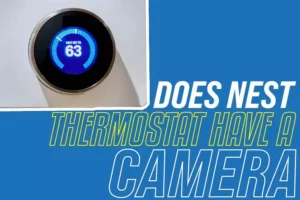
Nest thermostat, also known as Nest learning thermostat, is an intelligent thermostat developed and designed to be electronically programmable to work on Wi-Fi internet to control and optimize the heating and cooling of homes and businesses in such a way that energy is conserved. This device was designed by electronics geniuses- Fred Bould, Ben Filson, and Tony Fadell. Nest Labs launched the Thermostat. Nest thermostat is Energy Star certified; the device learns about temperature ranges within a space and configures temperature regulations to suit your needs.
So, Does Nest Thermostat Comes with a Camera?
No, Nest Thermostat does not come with a camera or microphone.
What You Should Know About Nest Thermostat
Just before you install the Nest Thermostat, there are some things you should know.
1. Compatibility
The Nest Thermostat E is compatible with the 24V systems, and these systems include; forced air, heat pump, variable speed, radiant systems, and the standard fuel types such as electricity, natural gas, and oil.
The Nest Thermostat can control the heating and cooling of your environment, including one state of heating or cooling and another stage of cooling and heating. The Thermostat will also control a one-speed fan. You can check a comprehensive list of your Nest Thermostat compatibility on nest.com.works.
2. What is Included in the Box?
Aside from the Thermostat itself, there are some parts included in the package box, these are;
- The base
- The trim plate
- Wall screws and
- The display
How To Install Your Nest Thermostat
Nest Thermostat comes in two varieties, and these are; Nest Thermostat E and Nest Learning Thermostat. In most homes, installing Nest Thermostat can be very easy and should take less than 30 minutes. A Nest Thermostat app can make installation more accessible because it comes with a step-by-step guide or instructions for installation and wiring.
Use the Nest Thermostat app as your guide. Keep in mind that specific installations will require professional help; these include the dual fuel system or the heat pump with a furnace. The following steps apply to the installation of your Nest Thermostat;
1. Switch Off the Power
Switching off the power will protect you during the installation and also helps you avoid blowing a fuse inside the equipment or setup. To confirm the power is off, change the temperature with your current Thermostat, then wait for at least 5 minutes to ensure that your power system doesn’t shut off.
2. Remove the Cover from the Thermostat
While some thermostat covers will pop off, others will have to be removed mechanically. Ensure you unscrew the cover and keep in mind that some older thermostats will come with a second plate that must be removed to expose the wires.
3. Take a Picture of the wires
This procedure is a crucial step because it will guide you later on. Taking a picture of the thermostat wires and saving them will ensure you have a reference to use when completing the installation. Make sure you can read those wire terminal labels adequately.
Take note of the incompatible wiring connections. For instance, standard wires are not compatible with Nest Thermostat. High voltage wires, especially those labeled as 120V and 240V and those with very thick components, wire nuts, and the ones with L1 and L2 terminal blocks, are not compatible with Nest Thermostat because of their extremely high voltage.
You may also want to use the compatibility checker on nest.com/works, where you can enter your Thermostat’s wire descriptions into the checker to find out if they are compatible with your electrical system.
You must enter only the connectors on your Thermostat that have wires in them. Instead, don’t use wire colors; you should use the connector labels. Avoid entering jumper wires into the checker. If your system is compatible, you should receive a custom wiring diagram that will guide you to complete the installation of your Nest Thermostat. You may want to print or email this diagram to yourself.
4. Remove the Jumper Wires
Your Nest Thermostat doesn’t need jumpers, and these are short wires between connectors. You must remove jumper wires from your nest thermostat even before you commence installation. Keep in mind that not all Nest Thermostats come with jumpers. If you remove your jumpers, save them along with the old Thermostat.
If you have the Rh and Rc wires, there are dual transformers in the system. The Nest Thermostat E is not compatible with dual transformers, but you should be able to use the third-generation Nest Learning Thermostat.
5. Label Your Wires
The next step is to peel off the labels below the wires and attach them to the Thermostat’s matching wires. Put the R label on the Rc or Rh wires if you have them, for instance.
Wire colors may vary, but the commonest or C wires are usually colored blue. If there is an orange wire in the connector that is labeled both W and O/B, it means you have a heat pump, most likely. Put the wire in the Nest Thermostat’s O/B connector.
If you have a white wire in the connector that is labeled both W and O/B, then you are likely not with a heat pump; you can then put the wire in your Nest Thermostat W connector. If you are unsure about how to wire your Thermostat, you may want to go to Nest.com/install or contact a Nest Pro nearest to you.
6. Disconnect the Wires and Remove the Base
Once you have removed the Thermostat’s base, gently wrap those wires around a pen or pencil, so they wouldn’t fall back into the hole inside the wall. Keep in mind that your HVAC power must be switched off to avoid blowing a fuse in the device.
Mark where your screws will go, and use the in-built bubble level to ensure the base is leveled. If needed, use the trim plate. If you don’t want to paint over the old marks left by your previous Thermostat, you may use the optional trim plate.
Snap the thermostat base with the trim plate, then screw the plate to the wall. An electrical box may not be as common, but if you have one, you will have to purchase steel plates and screws from the nest.com website for proper installation.
Once you have your steel plates, secure them to the electrical box with two of the screws, then use the other two screws to attach the nest base to the trim plate.
7. Install the Nest Base, Connect the Wires, and Attach the Display
Pull the wires through the center of the base before attaching them to the wall with the screws. With the help of the diagram you got from the compatibility checker, connect your system’s wires to the Nest thermostat.
Keep in mind that if you have an R, Rc, or Rh wire, you need to put it inside the R connector on your Nest thermostat. If you have the W2, Y2, or O/B wire, you can put it into the *OB connector, if necessary.
Gently tug in each wire to check that they are secure and ensure that each connector that has a wire stays down. Once all the wires are securely connected, push them down to ensure they remain flushed to the base.
Attach the display by pushing it onto the base until it clicks. Switch the power back on once you have completed the installation.
Using Your Nest Thermostat with Nest App
Once you turn on the power source, the Nest Thermostat will turn on and guide you through the setup. You can select a Wi-Fi to connect it, choose your language, tell it something about your home to help the device conserve energy. Keep in mind that the Nest thermostat doesn’t come with a touchscreen; just turn the display and press it down to select your options.
You need to download the Nest Thermostat app for free, and you can control your Thermostat directly from your smartphone. This app will also send you monthly reports indicating your home’s energy usage. You should be able to get your app downloaded from Google Play or the Apple store. If you don’t have your smartphone with you, you can go to www.home.nest.com to download the app.
Add Your Thermostat to your account on the app. You can do this by tapping on the plus sign on the app’s home screen and then clicking on Nest Thermostat. Select “Thermostat,” and the app will automatically add your Thermostat to your account.
Your Thermostat will automatically start learning your schedule, or you can choose a schedule with pre-set time and temperatures. You can always edit your schedules at any time. You can go to nest.com/thermostatbasics to learn more about getting started with your Thermostat and using it.
The Nest Thermostat customer care is also available online if you need technical or non-technical assistance on your Thermostat.


